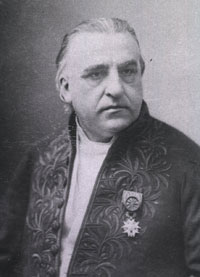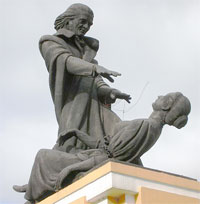Influential figures in the study and practice of hypnosis
Bernheim, Hippolyte (1843-1917)
 A Professor at the University of Nancy (a school whose ideas competed with the Salpetriere - particularly Charcot). He attempted to define suggestion more precisely and described verbal hetero-suggestion as the key to real hypnotism. He wrote:
A Professor at the University of Nancy (a school whose ideas competed with the Salpetriere - particularly Charcot). He attempted to define suggestion more precisely and described verbal hetero-suggestion as the key to real hypnotism. He wrote:
Bernheim, H., (Herter, C.A. trans.), Suggestive Therapeutics: A Treatise on the Nature and Uses of Hypnotism, (De la Suggestion et de son Application à la Thérapeutique, [Second Edition], 1887), G.P. Putnam's Sons, (New York), 1889.
Bernheim H., New Studies in Hypnotism, [Trans. by Sandor R.S, of Bernheim's French (1891) Hypnotisme, Suggestion, Psychothérapie: Études Nouvelles], International University's Press, (New York), 1980.
Braid, James (1795-1860)
 James Braid was a Scottish opthalmic surgeon. In 1841 he attended a show in Manchester by a French magnetiser called La Fontaine. Braid noticed that while subjects were being put to sleep on stage that there was first a noticeable quivering of the eyelids, then the eyeballs turned up and the subjects fell asleep. He studied animal magnetism and was particularly interested in eye fatigue and later in fatigue of the "inner or psychic eye" He was the first to use the terms hypnosis, hypnotism, suggestion and hypnotist in the sense that they are used today - drawing parallels between hypnosis and sleep.
James Braid was a Scottish opthalmic surgeon. In 1841 he attended a show in Manchester by a French magnetiser called La Fontaine. Braid noticed that while subjects were being put to sleep on stage that there was first a noticeable quivering of the eyelids, then the eyeballs turned up and the subjects fell asleep. He studied animal magnetism and was particularly interested in eye fatigue and later in fatigue of the "inner or psychic eye" He was the first to use the terms hypnosis, hypnotism, suggestion and hypnotist in the sense that they are used today - drawing parallels between hypnosis and sleep.
Braid worked just prior to, and at the time when anaesthetics were first being discovered, and he used hypnosis successfully to perform surgery. He developed a technique for hypnotising people involving eye fixation. He would place a bright, shining object in front of the eyes of the subject, close to the nose and at the level of the forehead. By simply asking subjects to fixate on the object he found that the eyes and lids grew tired and quickly closed.
"My chief objective is not to exploit those elements that give rise to superstitious and magical belief, but to ensure that everything mystical is excluded from the circle of scientific hypnotic practice." (Braid, 1842).
Charcot, J. M (1825-1893)
 Worked at the Salpêtriere in Paris (which competed with the Nancy School). The Salpetriere viewed hypnosis as similar to hysteria. Charcot's pupils looked for physical signs (stigmata) in the hypnotised person to explain the hypnotic phenomenon. In 1870 Charcot was given responsibility for a ward of the Salpetriere consisting of female convulsive patients.
Worked at the Salpêtriere in Paris (which competed with the Nancy School). The Salpetriere viewed hypnosis as similar to hysteria. Charcot's pupils looked for physical signs (stigmata) in the hypnotised person to explain the hypnotic phenomenon. In 1870 Charcot was given responsibility for a ward of the Salpetriere consisting of female convulsive patients.
Chastenet, A. M. J. (Marquis de Puységur) (1751-1825)
A member of Mesmer's secret society "Harmonia". Described a state of 'articifial somnambulism'. He learned Mesmer's techniques in 1784.
Elliotson, John (1791-1868)
A famous London physician. Dr Elliotson often prepared patients for surgical operations by the use of mesmeric-magnetic treatment.
Erickson, Milton (1901-1980)
Milton Erickson was a Psychiatrist and Psychologist, highly regarded for his clinical work. He was the founding president of the American Society of Clinical Hypnosis.
Read more at the Milton H. Erickson Foundation.
Esdaile, James (1818-1859)
A personal friend of James Braid. Esdaile worked as a surgeon for the East India Company in Calcutta. He performed thousands of surgical operations, first with the use of Mesmeric passes, and later using Braid's hypnotism - he reportedly achieved complete insensibility in 80-90% of his patients (Völgyesi, 1966).
Faria, Abbé José Custodio di (1756-1819)
 A scholar and priest. He lived for an extended period in Goa and brought information back to Paris in 1813 concerning hypnotic-like techniques practiced in the Orient. Faria conducted public displays and published information in 1819. He thought the phenomenon were due to psychic effects, calling the magnetiser a 'concentrateur' and his magnetised client the 'concentré', and the magnetic or hypnotic process 'concentration' or 'sommeil lucide'. His method of hypnotising, which he termed 'fascinating' consisted of sitting opposite the subject, looking at him sharply, and then suddenly and energetically crying out "Sleep!" or "Go to sleep!". Other techniques involved rigid fixation of the gaze over a lengthy period.
A scholar and priest. He lived for an extended period in Goa and brought information back to Paris in 1813 concerning hypnotic-like techniques practiced in the Orient. Faria conducted public displays and published information in 1819. He thought the phenomenon were due to psychic effects, calling the magnetiser a 'concentrateur' and his magnetised client the 'concentré', and the magnetic or hypnotic process 'concentration' or 'sommeil lucide'. His method of hypnotising, which he termed 'fascinating' consisted of sitting opposite the subject, looking at him sharply, and then suddenly and energetically crying out "Sleep!" or "Go to sleep!". Other techniques involved rigid fixation of the gaze over a lengthy period.
There is lots more information at AbbeFaria.com
Gassner, Father Johann (1727-1779)
Gassner used catharsis as a method for treating physical illness - in particular he used the exorcism rites of the Catholic Church. His methods are thought to have influenced Mesmer.
Hell, Father Maximillian (1720-1792)
Hell's approach was based on the belief in the magnetic properties of the human body, and that magnets could be used to cure physical illness. He was a Professor at the University of Vienna and taught Mesmer.
Hilgard, Ernest (1904-2001)
Hilgard was a key figure in hypnosis research, and produced an influential neodisociation theory of hypnosis. Read an obituary for Ernest Hilgard here.
Hull, Clark L (1884-1952)
Hull is credited with pioneering the modern study of hypnosis. He conducted investigations with considerable methodological rigour and published Hypnosis and Suggestibility in 1933.
Mesmer, Franz Anton (1735-1815)
 Mesmer studied medicine in Vienna, receiving his doctorate in 1766 with a dissertation on the influence of the planets on the human body. He expounded a theory of animal magnetism, or mesmerism, which held that every body possessed a magnetic force which connects all human beings. In 1775 he published his theory in Sendschreiben an einen auswärtigen Arzt. He believed sickness was the product of blockages in the flow of an invisible magnetic fluid, and that these blockages could be reversed through 'passes' of his hands over affected body parts.
Mesmer studied medicine in Vienna, receiving his doctorate in 1766 with a dissertation on the influence of the planets on the human body. He expounded a theory of animal magnetism, or mesmerism, which held that every body possessed a magnetic force which connects all human beings. In 1775 he published his theory in Sendschreiben an einen auswärtigen Arzt. He believed sickness was the product of blockages in the flow of an invisible magnetic fluid, and that these blockages could be reversed through 'passes' of his hands over affected body parts.
In his doctoral dissertation in 1766 Mesmer emphasised that it was not only the planets, stars and other cosmic powers that extended influence upon living creatures, but that there were other 'etheric' powers that emanated amongst living things.
For a fuller description of Mesmer's life follow this link.
Orne, Martin (1927-2000)
 Orne was a psychiatrist, clinical psychologist, and researcher. He conducted many critical investigations of hypnosis, and his contributions to experimental methods are still used today.
Orne was a psychiatrist, clinical psychologist, and researcher. He conducted many critical investigations of hypnosis, and his contributions to experimental methods are still used today.
There is a site dedicated to Martin Orne at the University of Pensylavia department of Psychology here.
Spanos, Nicholas (1942-1994)
Read an obituary for Nicholas Spanos here.
Weitzenhoffer, André (1921-2005)
Read an obituary for Andre Weitzenhoffer here.
What is hypnosis?
Definitions of hypnosis
Types of suggestion
FAQ
Scientific theories of hypnosis
History of hypnosis
Animal hypnosis
Key people in hypnosis
Demand characteristics
Scientific research
States of consciousness
Neuroscience
Modification of suggestibility
Attention and hypnosis
Pain research
Hypnosis as a research tool
Genes and hypnotizability
What is hypnotherapy?
Is it effective?
Finding a therapist
Depression
Irritable bowel syndrome
Pain
PTSD
Smoking
Surgery
Weight loss
Hypnosis research papers
Suggestibility scales
Scripts
Videos
Forum
Organisations
Journals
Book reviews
© 2007-2019 Dr Matthew Whalley
